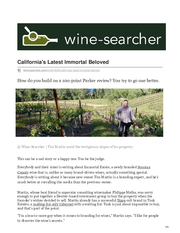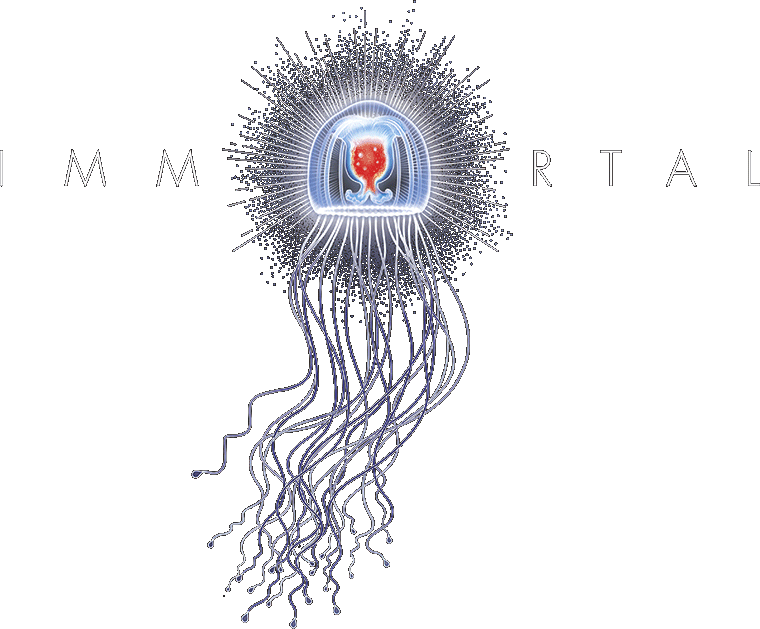How do you build on a 100-point Parker review? You try to go one better.

This can be a sad story or a happy one. You be the judge.
Everybody and their sister is writing about Immortal Estate, a newly branded Sonoma County wine that is, unlike so many brand-driven wines, actually something special. Everybody is writing about it because new owner Tim Martin is a branding expert, and he's much better at corralling the media than the previous owner.
Martin, whose best friend is superstar consulting winemaker Philippe Melka, was savvy enough to put together a Denver-based investment group to buy the property when the founder's widow decided to sell. Martin already has a successful Napa cult brand in Tusk Estates, a mailing-list only Cabernet with a waiting list. Tusk is just about impossible to buy, and that's part of the point. "I'm a less-is-more guy when it comes to branding for wines," Martin says. "I like for people to discover the wine's secrets."
The new Immortal Estate has some secrets to discover.
The 165-acre property is in a valley that once held a remote hunting lodge at up to 500 meters (1640 feet) of elevation snuggled in between Napa and Sonoma Counties. Pride is the only winery nearby, but you can't see it from the property. This story you've heard before: Lynn Hofacket and his wife Casidy Ward moved out from their native Oklahoma to wine country and wanted to develop something special, so they bought this ranch. The property, which Hofacket dubbed Hidden Ridge, could not be developed today. Much of the 50 acres of vineyards are on volcanic soils on a 55-degree slope. Germany's Mosel region might be the only other place in the world with vineyards that steep. It's mind-boggling to stand at the top looking down and think about the workers who have to tend the vines. They're not on the electricity grid so equipment has to be powered by gasoline or generators.
If you're wondering if it was illegal to plant vines there, Martin says Hofacket was fined three separate times. Sonoma County code doesn't allow planting on slopes higher than 15 degrees, and "now they would shut you down", Martin says. But the vines are there now and the vineyard has been grandfathered in.
The vineyard was a labor of love for Hofacket, a construction magnate before he got the wine bug.
"Lynn didn't have a vineyard management team," Martin says. "He did everything himself with the help of one guy." But marketing wasn't Hofacket's strength. Despite strong critical reviews, he struggled to sell the wines. Part of it he blamed on the Sonoma County appellation: the vines are 100 percent Cabernet Sauvignon, but as Hidden Ridge sits alone it doesn't have a prestigious Cabernet AVA it could use. It is technically part of the Fountaingrove AVA, but nobody knew where that is before and now, Martin says, "It sounds like fire." (Martin said he could see a ring of fire around the property last fall, but he says the ridge wind kept smoke from descending into the grapes.)
© Immortal Estates | The jellyfish logo has a meaning – and no, it's doesn't involve being stung.
Martin thinks Hidden Ridge just isn't a great name for a wine, even though it perfectly describes the property. He's keeping the vineyard name but not for the wine brand itself.
"One of the first things I noticed was that people called it Hidden Valley, like the ranch dressing," Martin says.
Hofacket bounced his prices up and down, at one point charging just $40 a bottle for one of the few wines that may have cost that much to produce, given the remoteness of the vineyard. In 2010 he decided the grapes weren't up to his standards so he didn't pick them. In 2011, a wet and cool year, he made only a second-label wine. The next main release, 2012, cost $80 a bottle.
In December 2014, Robert Parker gave 97 points to the 2012 Hidden Ridge Impassable Mountain Cabernet Sauvignon, and he gave a preliminary score of (96-98+) to the 2013 vintage. Those were the highest scores the Wine Advocate had given Hofacket, and he must have felt partially vindicated. On March 3, 2016, Parker released his final rating for the 2012 wine. He gave it 100 points, writing: "If you want a quintessential example of what perfection is in my business, taste this wine ... the incredible pure aromatics of blue, red and black fruits, the minerality, the volcanic, earthy sweetness that emerges in a subtle fashion, the full-bodied opulence, the staggering finish of more than a minute, and its unreal concentration certainly make this one of the most compelling and profound Cabernet Sauvignons I have ever tasted ... This should be nearly immortal ... a legacy wine from Sonoma." Now THAT is vindication. But Hofacket did not live to read it; he had died in November 2015.
I'm struck by Parker's use of "immortal" because that is the word Martin chose to rebrand the wine after his group bought it from Hofacket's widow.
"I tried a 1905 Sherry once, and realized everyone who made this wine was gone," Martin said. "But their work, the wine they made with their hands, remained."
That's how he chose the name Immortal Estate, and the logo of a tiny jellyfish that, in theory, can live forever by regenerating itself back to a polyp. The marketing outreach was cheesy enough that I was skeptical; longtime readers know that skeptical is my default state. But after seeing the vineyard, I agree: it's special. Martin's team is replanting some of the vineyard to add other Bordeaux varieties – Cabernet Franc, Malbec and Petit Verdot – to add to the main wine. He's also planting Provence grapes around a lake at the bottom of the valley to create a Provence-style rosé.
"We spent the last year adding massive amounts of nutrients to the soil because the previous owner didn't want to do that," Martin says. "You have to give back to the earth or at some point she stops giving to you. Someone told me, why would you do anything to a wine that got 100 points from Parker? Because that's not how I think. I think you should always challenge yourself to be better." Immortal Estate will charge $303 for a wine that peaked at $125 under Hofacket. There are 500 cases of the 2014, and it's an impressive wine, with layers of berry flavors, some dark chocolate, fine-grained tannins that give a firm yet smooth mouthfeel, and a long finish. Hofacket created this wine. And it lives on.
